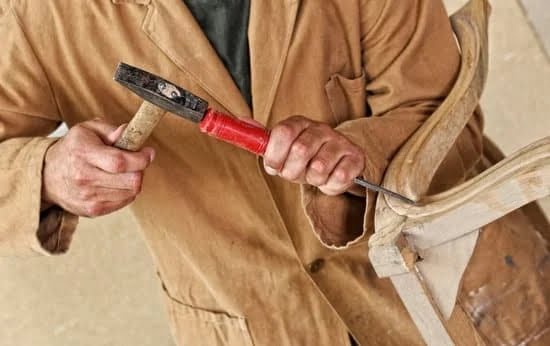Guide To Woodworking Tools
There is a wide variety of woodworking tools available on the market. Some are essential, while others are more optional. In order to get the most out of your woodworking experience, it is important to know which tools are necessary to have in your arsenal, and which ones can be left to the experts.
The following is a list of the most essential woodworking tools:
-Chisels: Chisels are used for a variety of purposes, such as removing small amounts of wood, cleaning out joints, and shaping wood. There are a variety of chisels available on the market, so it is important to select the right one for the job.
-Circular Saw: A circular saw is a power tool that is used to cut wood. It is a handheld saw that has a circular blade that spins. It is a versatile tool that can be used for a variety of projects.
-Coping Saw: A coping saw is a hand saw that is used to cut curves in wood. It has a thin blade that is held in a frame. This saw is ideal for shaping wood.
-Drill: A drill is a power tool that is used to drill holes in wood. It is a handheld tool that has a rotating bit that drills into the wood. A drill is a necessary tool for any woodworking project.
-Jigsaw: A jigsaw is a power tool that is used to cut curves in wood. It has a thin blade that moves up and down and side to side. This saw is ideal for cutting intricate curves in wood.
-Router: A router is a power tool that is used to shape wood. It has a rotating bit that cuts into the wood. A router is a necessary tool for any woodworking project.
-Saw: A saw is a hand tool that is used to cut wood. It has a thin blade that cuts through the wood. There are a variety of saws available on the market, so it is important to select the right one for the job.
-Tape Measure: A tape measure is a hand tool that is used to measure the length of wood. It is a necessary tool for any woodworking project.
These are the most essential woodworking tools. With these tools, you will be able to complete a variety of woodworking projects.
Hand Woodworking Tools Chisels Draw Knives
Gouges
There are many hand woodworking tools available on the market, but the three most commonly used are chisels, draw knives, and gouges. Chisels are used to cut wood away from the surface, draw knives are used to peel wood, and gouges are used to create or remove material from a surface.
Chisels are available in a variety of sizes and shapes, the most common of which is the standard bevel edge chisel. This type of chisel has a beveled edge that is used to cut away wood, and a flat edge that is used to strike the chisel with a mallet. Chisels are also available in a variety of other shapes, such as the mortise chisel, which has a square blade that is used to cut square holes in wood, and the dovetail chisel, which has a blade that is tapered to a point and is used to create dovetail joints.
Draw knives are also available in a variety of sizes and shapes, the most common of which is the standard draw knife. This type of draw knife has a blade that is curved towards the edge, and a handle that is perpendicular to the blade. Draw knives are also available in a variety of other shapes, such as the spokeshave, which has a blade that is curved away from the edge, and the rabbet plane, which has a blade that is perpendicular to the edge.
Gouges are available in a variety of sizes and shapes, the most common of which is the standard gouge. This type of gouge has a blade that is curved towards the edge, and a handle that is perpendicular to the blade. Gouges are also available in a variety of other shapes, such as the parting tool, which has a blade that is straight and is used to part wood, and the skew chisel, which has a blade that is angled towards the edge.
High Quality Woodworking Hand Tools Reviews
Why Use Hand Tools?
There are many reasons to use hand tools, even in today’s high-tech world. Some of the benefits of using hand tools include:
1. You can get a better sense of the material you’re working with. When you use your hands to work with wood, metal, or other materials, you can feel the texture and the resistance, which helps you to work more effectively.
2. You can have more control over the workpiece. With hand tools, you can make more precise cuts and maneuvers, which can result in a better finished product.
3. You can work more efficiently. Hand tools allow you to work faster and more accurately than power tools, so you can get the job done in less time.
4. You can work in more places. Hand tools don’t require a power outlet, so you can use them just about anywhere. This is especially useful when you’re working in tight spaces or in remote locations.
5. You can learn new skills. Hand tools are a great way to learn about woodworking and other crafts. With practice, you can become skilled at using a variety of hand tools, which will help you to produce better results.
Types of Hand Tools
There are many different types of hand tools, each with its own unique capabilities. Some of the most common hand tools include:
1. Chisels. Chisels are used for cutting, shaping, and removing material from wood or other materials.
2. Saws. Saws are used for cutting wood, metal, and other materials. There are many different types of saws, each with its own unique capabilities.
3. Hammers. Hammers are used for striking nails, bolts, and other objects. They come in a variety of shapes and sizes, each with its own unique capabilities.
4. Screwdrivers. Screwdrivers are used for turning screws. They come in a variety of shapes and sizes, each with its own unique capabilities.
5. Wrenches. Wrenches are used for turning bolts and nuts. They come in a variety of shapes and sizes, each with its own unique capabilities.
6. Chisels. Chisels are used for cutting, shaping, and removing material from wood or other materials.
7. Planes. Planes are used for shaping wood. There are many different types of planes, each with its own unique capabilities.
8. Measuring tools. Measuring tools are used for measuring the size, shape, and other dimensions of objects. They come in a variety of shapes and sizes, each with its own unique capabilities.
9. Marking tools. Marking tools are used for making marks on objects. They come in a variety of shapes and sizes, each with its own unique capabilities.
10. Cutting tools. Cutting tools are used for cutting materials. They come in a variety of shapes and sizes, each with its own unique capabilities.
Benefits of Using Hand Tools
There are many benefits to using hand tools, including:
1. You can get a better sense of the material you’re working with. When you use your hands to work with wood, metal, or other materials, you can feel the texture and the resistance, which helps you to work more effectively.
2. You can have more control over the workpiece. With hand tools, you can make more precise cuts and maneuvers, which can result in a better finished product.
3. You can work more efficiently. Hand tools allow you to work faster and more accurately than power tools, so you can get the job done in less time.
4. You can work in more places. Hand tools don’t require a power outlet, so you can use them just about anywhere. This is especially useful when you’re working in tight spaces or in remote locations.
5. You can learn new skills. Hand tools are a great way to learn about woodworking and other crafts. With practice, you can become skilled at using a variety of hand tools, which will help you to produce better results.
Industrial Woodworking Tooling
Industrial woodworking tooling is a broad category that encompasses a wide variety of tools used in many different ways to cut, shape, and join wood. While there are many different types of industrial woodworking tools, they can generally be divided into two categories: power tools and hand tools.
Power tools are tools that are powered by electricity or compressed air. They include saws, drills, routers, and sanders, among others. Power tools are fast and efficient, and they can be used to perform a wide variety of tasks.
Hand tools are tools that are powered by human muscle. They include hammers, chisels, screwdrivers, and wrenches, among others. Hand tools are slower and less efficient than power tools, but they are also less expensive and more versatile.
Industrial woodworking tooling is used to perform a wide variety of tasks, including:
– Cutting lumber
– Shaping lumber
– Joining lumber
– Sanding lumber
– Finishing lumber
Fine Woodworking Tools And Shops Pdf
There is no question that fine woodworking tools are a necessary part of any woodworking shop. However, the quality and price of these tools can vary greatly. It is important to select the right tools for the job, and to select the right tools for your budget.
There are a few basic tools that are essential for any woodworking shop. These include a tablesaw, a miter saw, a drill, and a screwdriver. In addition, a chisel and a hammer are also very useful. These tools are available in a variety of price ranges, and it is important to select the tools that fit your budget.
In addition to the basic tools, there are a number of other tools that can be useful in a woodworking shop. These include a bandsaw, a jointer, a planer, and a lathe. While these tools are not necessary, they can be very helpful.
When selecting tools, it is important to consider the type of projects you plan to work on. If you are primarily interested in furniture, then you will need a different set of tools than someone who is interested in carpentry. It is important to select the tools that are best suited for your needs.
When selecting tools, it is also important to consider the quality of the tools. Not all tools are created equal, and some tools are built to last while others are not. It is important to select the tools that are made with quality in mind.
The price of the tools is also important to consider. Not all tools are expensive, but there are a few high-end tools that can be quite costly. It is important to select the tools that fit your budget.
In the end, the type of tools you select is up to you. However, it is important to select the tools that are best suited for your needs. It is also important to select the tools that are within your budget.

Hi everyone! I’m a woodworker and blogger, and this is my woodworking blog. In my blog, I share tips and tricks for woodworkers of all skill levels, as well as project ideas that you can try yourself.





